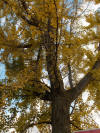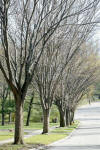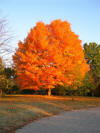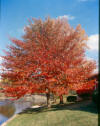Back to PlantPlaces.com Community Home
Hardy Trees for Urban Landscapes
What is an urban landscape? The phrase describes difficult planting conditions, like poor soils, small planting areas, or heat-reflective pavements. Imagine the median plantings along roadways or in parking lots. The soils are compacted, lacking in nutrients, doused with salt in the winter, and surrounded by pollution. And yet, there are plants that will not only grow, but thrive in these tough conditions. Choosing the right plant for the location is a big step in achieving success. Following is a list of trees that will tolerate harsh conditions and still thrive.
Gleditsia tricanthos var. inermis, Thornless Honeylocust
 A beautiful medium size tree that works well in both home landscapes and in 4'x4' planters in the sidewalk. Small leaves and an open, spreading crown give it a soft, delicate appearance. Yellow fall color and very little mess in the fall make this a perhaps over-used favorite in the landscape.
A beautiful medium size tree that works well in both home landscapes and in 4'x4' planters in the sidewalk. Small leaves and an open, spreading crown give it a soft, delicate appearance. Yellow fall color and very little mess in the fall make this a perhaps over-used favorite in the landscape.
Ginkgo biloba, Maidenhair Tree
 Large tree with a distinctive and picturesque branching structure. Some cultivars such as
'Princeton Sentry' have a more upright habit for tighter spaces. Unique, fan-shaped leaves with a bright yellow fall color. This tree is dioecious, meaning the male and female flower parts are on separate trees. The female tree produces a malodorous seed making it undesirable for landscaping. Most nurseries, however, only sell males.
Large tree with a distinctive and picturesque branching structure. Some cultivars such as
'Princeton Sentry' have a more upright habit for tighter spaces. Unique, fan-shaped leaves with a bright yellow fall color. This tree is dioecious, meaning the male and female flower parts are on separate trees. The female tree produces a malodorous seed making it undesirable for landscaping. Most nurseries, however, only sell males.
Zelkova serrata, Japanese Zelkova
 One of my absolute favorite trees. A large tree, rivaling the American elm for its vase-shape, dark-green foliage and handsome bark. Fall color is usually a yellowish-brown, admittedly not its best attribute. A stately and elegant tree that will tolerate a variety of conditions and should be more widely used than it is.
One of my absolute favorite trees. A large tree, rivaling the American elm for its vase-shape, dark-green foliage and handsome bark. Fall color is usually a yellowish-brown, admittedly not its best attribute. A stately and elegant tree that will tolerate a variety of conditions and should be more widely used than it is.
Acer rubrum, Red Maple
 A medium size tree, well-known for its brilliant red fall color. Numerous cultivars are available with shapes from upright and columnar to graceful and rounded. Be diligent in researching the cultivars as some may have better fall colors than others. Tolerant of wet soils, but not of overly urban settings.
A medium size tree, well-known for its brilliant red fall color. Numerous cultivars are available with shapes from upright and columnar to graceful and rounded. Be diligent in researching the cultivars as some may have better fall colors than others. Tolerant of wet soils, but not of overly urban settings.
Acer saccharinum, Silver Maple
 Often maligned as a "trash tree," but you can't argue with the gracious shade of a Silver Maple when the leaves are fluttering green to silver in the wind. Quick growing, large tree that is tolerant of a variety of conditions. Considered weak-wooded, perhaps you wouldn't plant this tree too close to the house. Yellowish brown fall color. Not commonly found for sale.
Often maligned as a "trash tree," but you can't argue with the gracious shade of a Silver Maple when the leaves are fluttering green to silver in the wind. Quick growing, large tree that is tolerant of a variety of conditions. Considered weak-wooded, perhaps you wouldn't plant this tree too close to the house. Yellowish brown fall color. Not commonly found for sale.
Quercus rubra, Red Oak
 One of the faster growing oaks, this large shade tree will happily grow in tough situations. Nice rounded symmetrical shape. The leaves are dark green in the summer, but can be red to brownish red in the fall.
One of the faster growing oaks, this large shade tree will happily grow in tough situations. Nice rounded symmetrical shape. The leaves are dark green in the summer, but can be red to brownish red in the fall.
Quercus imbricaria, Shingle Oak
 Another large oak, more pyramidal in shape when it's young, but rounding with age. Finer leaves than most oaks, they go from dark green in the summer to brownish-yellow in the fall. Leaves tend to persist during the winter as well.
Another large oak, more pyramidal in shape when it's young, but rounding with age. Finer leaves than most oaks, they go from dark green in the summer to brownish-yellow in the fall. Leaves tend to persist during the winter as well.
Nyssa sylvatica, Black Gum
 Another of my favorite trees. This medium size tree does very well in wet areas, but will tolerate more difficult conditions. Can grow in part shade or full sun and makes a beautiful specimen tree. Brilliant fall color ranges from bright yellows to orange and red.
Another of my favorite trees. This medium size tree does very well in wet areas, but will tolerate more difficult conditions. Can grow in part shade or full sun and makes a beautiful specimen tree. Brilliant fall color ranges from bright yellows to orange and red.